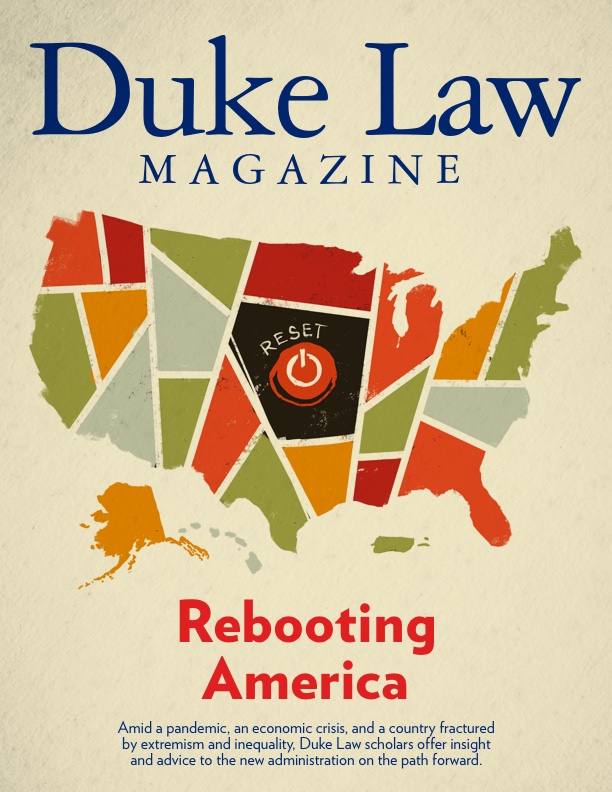
Administrative law and risk regulation | Jonathan Wiener
Improve systems for risk regulation

On his first day in office, President Biden signed a number of executive orders aimed at revamping the regulatory system. He rescinded executive orders issued by the prior administration that had arbitrarily focused only on the costs of regulation and downplayed the benefits. He issued a new order titled “Modernizing Regulatory Review” to restore the decades-old bipartisan consensus, shared by every presidency from the 1970s to 2016, in favor of assessing the full impacts of regulatory policy options, including both benefits and costs. Further, his order calls on federal agencies to develop new and improved approaches to regulation that will “promote public health and safety, economic growth, social welfare, racial justice, environmental stewardship, human dignity, equity, and the interests of future generations.” In addition, he issued another order on climate change that reinstated an important measure of the social and environmental damages caused by greenhouse gas emissions.
These are important directives through which the Biden administration will take a good look at making the regulatory system work better overall, yielding more benefits at lower costs. Notably, they retain the longstanding roles of assessing regulatory impacts, justifying policy choices with reasons, and exercising presidential oversight — while reinvigorating attention to the essential public values that such policies serve. The challenge ahead is to restore good judgment to the review of each agency rule, and further, to recognize and address the multiplicity of risks we face. 2020 was a year of multiple neglected risks — including COVID, climate, cyber, economic, and violence — interconnected crises that revealed vulnerabilities in our fragmented policy systems. We need new approaches that are both creative and careful to address this multi-risk world.
In a world of rapid change, past policies may become outdated, while new risks arise. These challenges call for improved mechanisms to assess policy options, learn best approaches, provide better foresight, and better manage multiple interconnected risks.
On climate change, the Biden-Harris administration is pursuing an integrated government-wide approach that brings every agency into action. This includes rejoining the Paris Agreement, and policy measures to reduce greenhouse gas emissions — potentially through new legislation (if feasible in the new Congress) or agency rules under older laws (if they survive challenges in court). In addition to or perhaps instead of some regulation, the new administration appears interested in a “green recovery” — using the federal spending power to connect climate change to the recovery from the coronavirus pandemic and the economic downturn. An investment in jobs and infrastructure could help address public health and foster the transition to a lower-carbon emissions economy, such as by building charging stations across the country for electric vehicles and expanding wind and solar generation.
On regulatory improvement, several further steps look promising. First, full assessment of both benefits and costs is the right starting point. People want and deserve the benefits of good regulation; they also want and deserve to avoid needless burdens. If benefits are low, or costs are high, or ancillary impacts go awry, or distributional effects are inequitable, that may disserve social outcomes and undermine public support for good regulatory programs. Further, if regulations remain static while the world changes, the emerging mismatch may cause harms — to innovation and prosperity, as well as to public health and environment — and breed public frustration.
Second, modernizing our regulatory system should make it more adaptive, learning and updating over time to better match the changing world. One key approach is to see how well our past regulations have actually been working. Almost every president over the last five decades has sought retrospective review of past rules. But these have tended to be ad hoc, one-time requests from each administration (and often focused on cutting the costs of the regulations, rather than on looking at both the benefits and the costs). And they typically asked the agency that issued the rule initially to devote scarce resources to doing the retrospective review.
The retrospective review process might work better if it were more regularized, looked at both benefits and costs, and looked not just at each rule issued by each agency one at a time but at multiple rules to learn by comparing which ones are working better or not and why. Retrospective review could also look at multiple regulatory impact assessments to test which forecasts of their future impacts were more accurate than others. Taking a multi-agency, multi-rule approach to retrospective review — perhaps through an inter-agency group, or a separate expert body — might be a more successful way to advance regulatory learning. And as each new rule is adopted, it could include plans for data collection and analysis to facilitate future review.
Beyond one-time retrospective reviews, adaptive assessment of important regulatory programs could flow into an ongoing process of periodic reviews. There are already some statutes enacted by Congress that call on agencies to review their rules every five, eight, or 10 years. That approach could be made more widespread, by statute or by agency policy, making these reviews an opportunity for ongoing learning and updating. Such periodic reviews would be most warranted where the policies have major impacts, the expected gains from learning are high, and the costs of assessments are reasonable.
Third, a more adaptive system of risk regulation needs to look ahead. Our current system of executive and judicial regulatory review, both for new rules and past rules, is often reactive, occurring after Congress has enacted a statute and an agency has proposed a rule. But as 2020 has shown, we face emerging new risks in a multi-risk world, with complex interconnections and tradeoffs. A new national risk/safety board could help with scanning across multiple risks, foreseeing emerging risks, identifying policy gaps and inequities, advising on priorities, overcoming fragmentation and tradeoffs across agencies, learning from surprise “policy shocks,” and crafting better strategies to reduce risks. This national risk/safety board would provide expert advice and coordination to help leaders and the public anticipate and navigate multiple risks.
The challenges facing the new Biden-Harris administration — and the country — are multiple and interconnected. Risks, and the policy responses to risks, pose ripple effects. A crisis like pandemic disease or climate change, and the policy responses to it, pose multiple impacts — health (physical and mental), economic, social and environmental — which need careful and creative management. In a world of rapid change, past policies may become outdated, while new risks arise. These challenges call for improved mechanisms to assess policy options, learn best approaches, provide better foresight, and better manage multiple interconnected risks.

